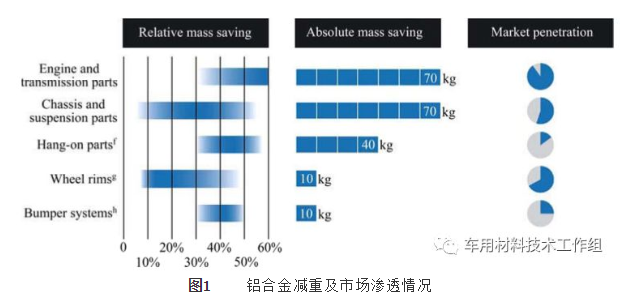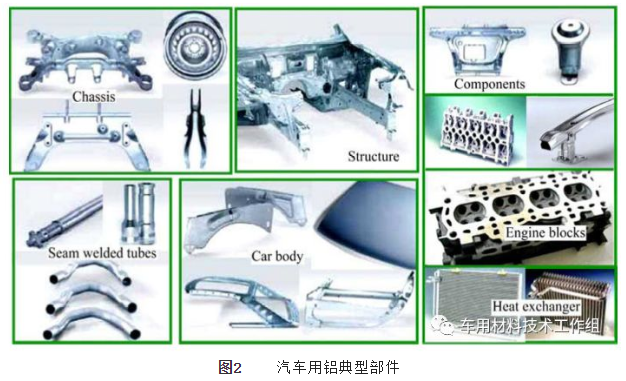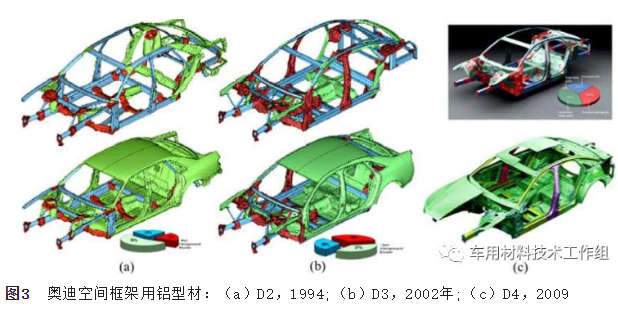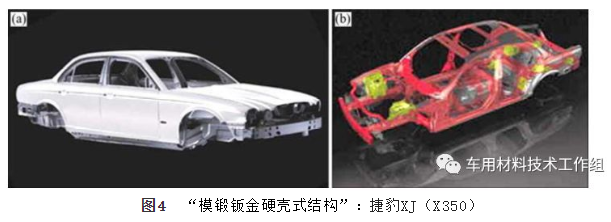The European automobile industry is famous for its advanced and highly innovative. With the promotion of energy saving and emission reduction policies, in order to reduce fuel consumption and carbon dioxide emissions, improved and innovatively designed aluminum alloys are widely used in automobile design. According to statistics, in the past ten years, the average amount of aluminum used in passenger cars has doubled, and the weight reduction of aluminum alloys is shown in Figure 1 below. Based on innovative design concepts, this trend will continue in the next few years.
In the process of lightweight development, aluminum alloys are facing fierce competition with other new materials, such as high-strength steel, which can still maintain high strength after thin-walled design. In addition, there are magnesium, titanium, glass or carbon fiber composite materials, the latter of which are already widely used in aerospace. Now the concept of multi-material design has been integrated into automobile design, and efforts are being made to apply suitable materials to suitable parts. A very important challenge is the problem of connection and surface treatment, and various solutions have been developed, such as engine block and power train components, frame design (Audi A2, A8, BMW Z8, Lotus Elise), thin plate structure (Honda NSX, Jaguar, Rover), suspension (DC-E class, Renault, Peugeot) and other structural components design. Figure 2 shows the components of aluminum used in automobiles.
BIW Design Strategy
The body-in-white is the heaviest part of a conventional car, accounting for 25% to 30% of the vehicle’s weight. There are two structural designs in the body-in-white design.
1.”Profile space frame design” for small and medium-sized cars: Audi A8 is a typical example, body in white weighs 277 kg, consists of 59 profiles (61 kg), 31 castings (39 kg) and 170 sheet metal (177 kg). They are joined by riveting, MIG welding, laser welding, other hybrid welding, gluing, etc.
2. “Die-forged sheet metal monocoque structure” for medium to large-capacity automobile applications: for example, Jaguar XJ (X350), 2002 model (as shown in Figure 4 below), 295 kg mass “stamped body monocoque structure” body-in-white consisted of 22 profiles (21 kg), 15 castings (15 kg) and 273 sheet metal parts (259 kg). The connection methods include bonding, riveting, and MIG welding.
Application of Aluminum Alloy on Body
1. Age hardened Al-Mg-Si alloy
The 6000 series alloys contain magnesium and silicon and are currently used in automotive body sheets as A6016, A6111 and A6181A. In Europe, 1-1.2mm EN-6016 has excellent formability and corrosion resistance and is widely used.
2. Non-heat treatable Al-Mg-Mn alloy
Due to its specific high strain hardening, Al-Mg-Mn alloys exhibit excellent formability and high strength, and are widely used in automotive hot-rolled and cold-rolled sheets and hydroformed tubes. Application in the chassis or wheels is even more effective because the mass reduction of unsprung moving parts additionally enhances driving comfort and reduces noise levels.
3. Aluminum profile
In Europe, completely new car concepts were proposed based on aluminum profile design, for example, aluminum alloy frames and complex substructures. Their great potential for complex designs and functional integration makes them best suited for cost-effective series production. Because quenching is required during extrusion, medium strength 6000 and high strength 7000 age hardenable alloys are used. Formability and ultimate strength are controlled through age hardening by subsequent heating. Aluminum alloy profiles are mainly used in frame design, crash beams and other crash components.
4. Aluminum casting
Castings are the most widely used aluminum components in automobiles, such as engine blocks, cylinder heads and special chassis components. Even diesel engines, which have greatly increased their market share in Europe, are shifting to aluminum castings due to increasing demands for strength and durability. At the same time, aluminum castings are also being used in frame design, shaft parts and structural parts, and high-pressure casting of new AlSiMgMn aluminum alloys has achieved higher strength and ductility.
Aluminum is the material of choice for many automotive applications such as chassis, body and many structural components due to its low density, good formability and good corrosion resistance. Aluminum used in body structure design can achieve at least 30% weight reduction under the premise of meeting performance requirements. Also, aluminum alloys can be applied to most parts of the current cover. In some cases with high strength requirements, 7000 series alloys can still maintain quality advantages. Therefore, for high-volume applications, aluminum alloy weight reduction solutions are the most economical method.
Edited by May Jiang from MAT Aluminum
Post time: Dec-08-2023





